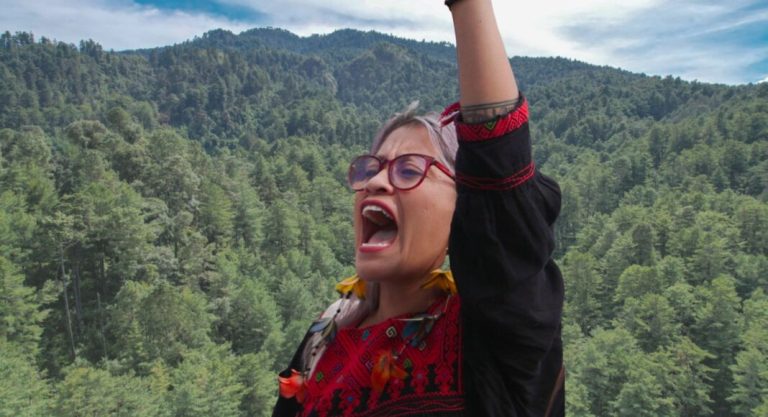
Honouring Indigenous resistance in Totonicapán: interview with Maya K’iché exile Lucía Ixchíu
06 September, 2024Latin America Bureau interviewed environment defender Lucía Ixchíu of the K´iché Maya of Totonicapán, a community famous for its ‘48 Cantons’ resistance movement.
Totonicapán was the second most important city of the K’iché and the headquarters of the last Mayan ruler, Tecún Umán. A major uprising against Spanish domination took place in Totonicapán in 1820.
In this interview, Lucía explains that Guatemalan Indigenous peoples continue to be intimidated, threatened, and attacked by the agents of the extractive industries operating in her homeland. She reports that the expansion of mining and logging has brought about a ‘fourth invasion’ of the region by multinational companies, whose activities have displaced communities and caused serious damage to the local and regional ecosystems. In 2012, seven members of Ixchíu’s community were killed by the police during a demonstration against the privatisation of the electricity supply.
Lucía tells the story of her path to political activism, her awakening to her role in creating solidarity among diverse Indigenous communities in Guatemala resisting oppression; and her life in exile, from where she continues to lobby foreign governments to support democracy, the rights of Indigenous peoples, and the protection of the environment in Guatemala.
Main image: Eliana Lafone
LAB: Lucía, you spoke at an event during the United Nations Permanent Forum on Indigenous Issues here in New York, where you explained the struggles of the Indigenous peoples of Guatemala in protecting their territorial rights and the rights of nature. I would like to ask you about your life and the trajectory of your political activism. Could you tell us why you had to leave Totonicapán and go into exile?
Lucía Ixchíu: This goes back more than 10 years to when I decided to become a journalist and an activist, leading the defence of our territory. This was following the massacre of my people on 4 October 2012, when seven people died and 40 were seriously injured. I am from a [Maya K’iché] community, organised into what are known as the ‘48 cantons of Totonicapán’, which collectively defend Indigenous territory and protect the forest.
We are the owners of land which is one of the most important sources of water for Central America. The rivers that originate here flow to Mexico and to Honduras. The area is important for biodiversity, but it has been impoverished, ravaged, besieged by colonisers. But the people, our people, our Indigenous organisation, have held together over time. Up until the time of the massacre, for us it was logical and natural, normal, to protect the forest, but then when the massacre happened, it became important to tell the story.
How did your family experience the massacre in Totonicapán?
It was the government, the army, the State, that was responsible for the massacre. They began to persecute my family, because my father was the lawyer for the widows whose husbands had been killed. My brother was on the frontline. The mainstream media was brutal and racist, suggesting that the savage Indians of Totonicapán deserved to be killed because they were Indigenous. I said, ‘No, this is not right. What the media is saying is not true.’ This was the narrative 10 years ago, and I was shocked by it.
What about the ‘Agreement on a Firm and Lasting Peace in Guatemala’ that was signed in 1996?
Guatemala experienced a genocide [against the Indigenous population] for 36 years, followed by –supposedly– a peace agreement in 1996, leading to a return to democracy. But we believe that the peace agreement was just a means for the economic elite to give the impression that they were now ‘good’ and democratic. The Peace Agreement led to a Free Trade Treaty being signed, which enabled the extractive industries to invade our territories [the Central America-US Free Trade Agreement signed with several Central American countries in 2004, came into force in Guatemala on July 1, 2006]. From then on there were political prisoners, dispossession, and violence, as the extractive industries moved into our territory with government support, backed up by the armed forces.1)
With the arrival of the extractive industries in 2005, Indigenous peoples once again found themselves facing genocide, war, colonialism; this time it was a consequence of collaboration between the extractive industries and the government.
Guatemala became a corporatised state, acting in the interest of private industry. Government agents became like CEOs of corporations, clearing the way for companies to operate.
Which companies are we talking about?
There are US and Canadian companies, such as Goldcorp [which closed the controversial Marlin mine in 2017], companies financed by European capital, such as the Cobra Group in which Florentino Pérez, the president of Real Madrid, is invested. They control much of the hydroelectric capacity of the north of the country that borders Mexico.
Other foreign companies include Hidro Santa Cruz, Hidro San Luis, Perenco [an Anglo-French oil and gas company], CGN [Compania Guatemalteca de Niquel] and Pronico. 2)
In the case of all of these foreign companies involved in the extractive industries, the ruling colonial oligarchy are involved in some way.
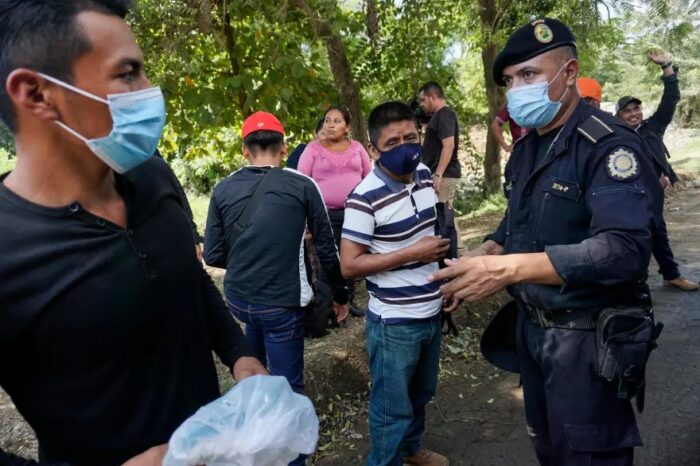
What happened to the supposed return to democracy?
How did Guatemala return to being a dictatorship? The Constitution was violated in 2017 because elections to the Supreme Court (which should happen every eight years) did not take place: the judges remained in place illegally, creating a judicial dictatorship. The judges fabricated cases against land defenders, journalists, lawyers, and activists, who were prosecuted, imprisoned, and tortured. By this time many people had gone into exile, but I never thought that it would happen to me.
What strategies have you used to be able to tell your story to the world?
I realised that not everyone thinks like us, because it is not the way the economy works, nor is it state policy. Then the solidarity from outside that was shown to our community after the massacre taught me that it was not just our community that was experiencing violence, it was happening in other territories too.
The massacre opened my eyes to the world and to my country: I became aware that people like me who protect the earth suffer assassinations, imprisonment, persecution. I soon realised that I am an Indigenous woman of the twenty-first century: I have the internet and I know how to use it, I can write, I can speak the language, so I am going to tell our story and that of other communities who do not have someone like me to tell their story from an Indigenous perspective.
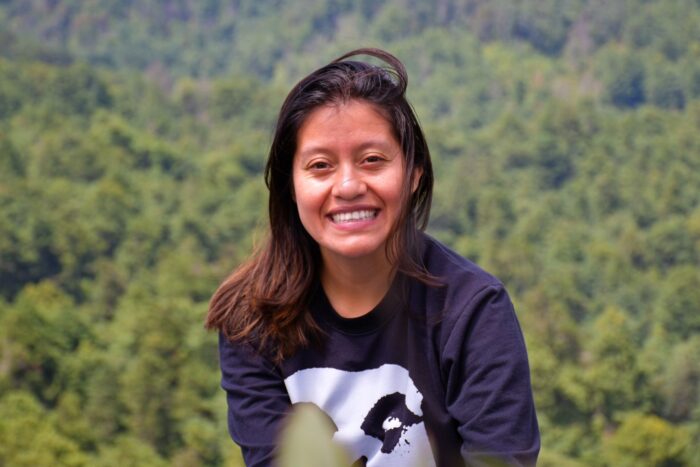
I decided to challenge the hegemonic narrative of the mainstream media and to write short commentaries. I was ashamed to write, and it was hard for me, but I had to explain what was happening in the resistance to mining, to hydro-electric dams, to monoculture; that there were people being imprisoned for defending the rivers and the hills. I became a spokesperson, and they did not like it.
I began to use social media. We were never going to have access to TV, to radio, to the printed press, never; they were closed to us. But I did not need that access: I had Facebook. On Facebook, on Twitter, on Instagram, we began to upload photos and text, blogs. I began to appear live on Facebook, which was different 10 years ago; it was not commercialised as it is now, not controlled by algorithms.
Is that a problem for you?
Yes, there are more and more networks and information. Before there was text and photographs, now there is video. We have had to learn from experience ourselves, on our own, as who is going to support an Indigenous news service talking about Indigenous matters?
Were there articles in the Spanish newspaper El País , for example?
El País did not want to interview me. I asked for space: I said, ‘I am here, I am a refugee’, but Guatemala is not of interest to Spain. I was knocking on doors, but for me to access the media to tell my story was extremely difficult.
I asked myself, ‘what are we going to do?’ No one, not even in Guatemala, wanted to tell our story, nor did they want us to tell our own story, as an act of self-determination.
It was then that I decided to become a journalist and an activist. Together with two friends I created an art collective in 2012 [Festivales Solidarios], to channel our anger into defence of our territory against mining, against hydroelectric plants. I became a student leader, the first Indigenous woman student leader in the historic Public University of San Carlos (USAC), a university that has now been destroyed by organised crime. The rector, Walter Mazariegos, has taken away the university’s autonomy. He is involved in narcotics and people trafficking himself. [In April 2022, students occupied the university for two months, on the grounds of what they said was Mazariegos’ fraudulent election in which only those who voted for him were allowed to vote, an allegation backed up by the US Department of State, which sanctioned him.]
What did you study at the University of San Carlos?
I am an architect, but I did not want to be an architect of capitalism, I did not want to build in cement, as they taught me in the university. They brainwash you into building in cement. How do you avoid using cement in construction? By using earth, adobe. Building with adobe is so basic: it has been used for centuries, but it does not occur to anyone now. What was frustrating to me when I was writing my thesis, when I designed a community centre, a library in a cultural centre –art being important in my life and politics– I wanted to build it using adobe. The university did not allow it, because they said that to make a viable construction out of adobe, I had to develop a methodology to calculate the resistance of the materials to earthquakes. That is very specialised: if the university wanted me to do that, it would be a doctorate. You cannot ask me to develop a methodology on the resistance of adobe for a bachelor’s degree. So I was forced to use cement.
When did you leave Totonicapán and what did you do after you finished your degree?
I left my town at 21. The year that I moved to Guatemala City to complete my degree, the massacre in Totonicapán took place, so I began to organise activities there [in Guatemala City], denouncing the massacre, after which we began to organise resistance and defence of territories in different parts of the country. I moved around. Guatemala is small, but the Indigenous territories are isolated. There is little infrastructure, few roads, so it takes a day, two days, to go from one place to another. I based myself in the capital, as it was easier to visit the territories from there.
We began to organise festivals and processions, which we took to different parts of the country. We began to open space for Indigenous and community participation, for artists in the resistance. When the people began to participate, bands of musicians emerged, which amazed me. We realised that we were not the only ones who are suffering. We began to bring different resistance groups together so that they could get to know each other and communicate. Exchanges began among anti-mining and anti-hydroelectric dam groups, water defenders.
As we began to build a community, the problem was always resources: who will pay for transport? I arranged for the Public University [of San Carlos], where I was studying, to guarantee the payment for transport. We slept where we could in the community, we ate with them. (This was around 2013.) It was a struggle to reach the communities. I continued doing this until the pandemic in 2020.
https://www.youtube.com/embed/CB5PRBKD_as?feature=oembed&enablejsapi=1
Lucia’s art collective, Festivales Solidarios, won an ‘artivism’ grant in 2022 focused on land defence through art initiatives.
What were the dangers that you faced in continuing your political activism?
It was after the massacre of 2012 that we began to understand the links between the army, narco-traffickers and the extractive industries: they are almost one entity, different elements of a cohabitation. The persecution, the violence: you do not know if it comes from the government, or a paramilitary group, or a company. From around 2014, I was targeted, attacked in the street, arrested by the paramilitaries, subjected to a defamation campaign, there were threats against me and my family.
I have two open cases against me. One for my investigative work documenting massacres, violence, tracing disappearances associated with the dictatorship in the period of transitional justice. The families of the disappeared, who survived the violence, were organised during and after the war, searching for their lost relatives. What happened in the peace process was that the daughters of the military aggressed us in the courtroom, threatened us and told us that we could not take photographs of their parents, even though it was them who were accused of the massacres.
There was impunity because the military are in the government, they have been in control of the government since the war, they know they have the power to attack, as they have done for 36 years.
The dictatorship continued. When we were attacked by these women and reported them, we found that they had already denounced us, accusing us of attacking them. The justice system wanted a reconciliation with these kinds of people: we said no. That case is still open. They have accused me of having attacked them, which is untrue. And then in 2020, during a protest that got out of control, they wanted to blame me for things that were nothing to do with me.
I left my country in 2020 during the pandemic, as we could not stay at home in Guatemala, because, being a dictatorship and, ignominious as they are, the government stole the funds for vaccinations. [There were alleged irregularities in President Alejandro Giammattei’s purchase of Russian covid vaccines.]
During the pandemic they began to assassinate environment defenders and forest guardians. Illegal loggers in different parts of the country –agents of extractivism, of mining– took advantage of the pandemic to kill environment defenders. No one knew, apart from us. We began to mobilise. After three months –March, April, and May [of 2020]– we went out to demonstrate against President Alejandro Giammattei and against the Attorney General Consuelo Porras 3) who stole the vaccination funds. The whole world knew about it, it is not a secret. There was so much indignation that we had been left without vaccinations, there was an uprising against the government. And as a result of the protests, I had to leave the country.
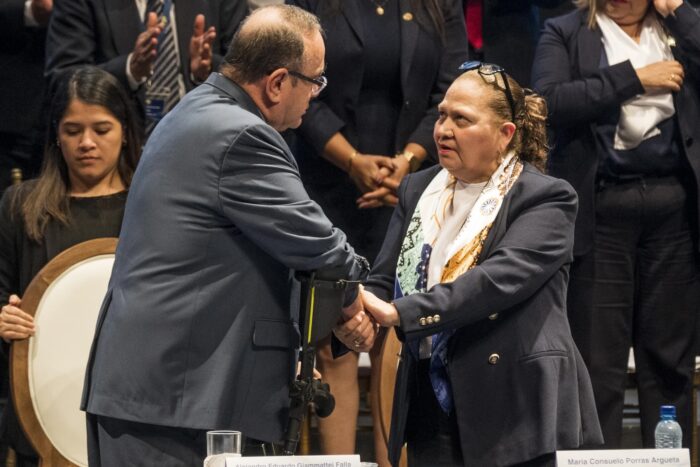
But not everything has been a disaster. There has been solidarity, hope, and collaboration among communities. That is why the strike lasted for 106 days in Guatemala, because there was communication and coordination.
This article is funded by readers like you
Only with regular support can we maintain our website, publish LAB books and support campaigns for social justice across Latin America. You can help by becoming a LAB Subscriber or a Friend of LAB. Or you can make a one-off donation. Click the link below to learn about the details.Support LAB
What has been your experience of living in exile?
When I arrived in Spain to request political asylum, I started to tell people what was happening in Guatemala, but they did not know where Guatemala was; they knew nothing about Guatemala. But in terms of the interests of capital, yes, we did exist, as objects to be exploited and dispossessed, but not as human beings, who had a history, who had a voice. There were Spanish companies engaged in extraction from our territories, but Spanish people in general did not know that we existed.
Finding solidarity in Spain was difficult, but Amnesty International Spain took on my case. They organised a tour of Spain for me to Galicia, to the Basque Country, Barcelona, Madrid. They organised events for me to present the situation in Central America, and in Guatemala. As I said, people in Europe do not even know which countries are in Central America … they do not even know that Guatemala exists…let alone being interested in my story as a defender of Indigenous land.
Why did you leave Spain for Mexico?
We knocked on many doors, we told them what we were doing. I have my speech, my way of looking at the world, and I feel that Europe, and particularly Spain, as the imperial power, is not ready to engage with radical Indians like me. It makes them uncomfortable. I experienced resistance to what I was saying, because when I began to talk about Guatemala, I had to talk about Spain’s colonial history and its responsibility for colonial history in my territory, which is ongoing as they continue to extract from us –– and they did not like it. They said, ‘please, talk about the present’, but when I say that the community’s rivers are being destroyed, when I mention that friends and associates, whom I name, have been affected by the actions of such-and-such company, when I argue that colonisation has not ended, it makes them uncomfortable.
So I decided to live in Mexico as it was difficult to be in Europe as an immigrant, as a refugee. Building solidarity in Europe over a three-month tour is one thing: actually living there as a migrant is another.
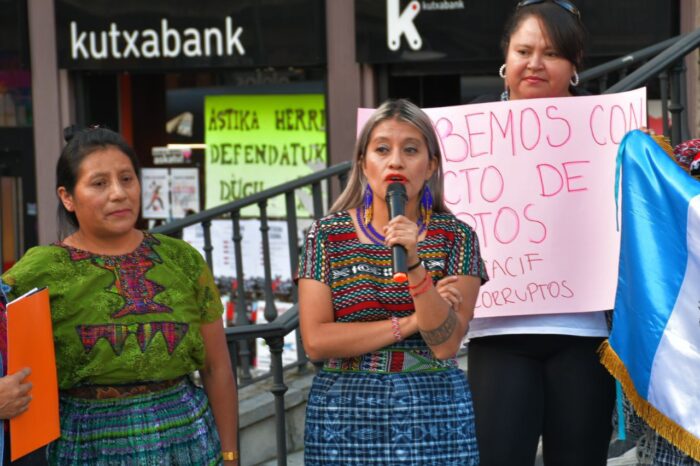
My status [in Spain] was both as a refugee and as a migrant. A friend said to me, ‘As you are not living in your territory anymore, you are no longer “exotic”.’ I was surprised, but that is the way it is. They want to bring us from our communities to tell them what is happening, but when we come to live among them, as refugees, we are viewed [negatively] like all the other refugees. That’s how I was treated, when I spoke and wrote as a refugee.
RFI [Radio France Internationale] in Paris, they did interview me and my professional partner, but it was only because there was a 106-day general strike in Guatemala led by an Indigenous organisation from my town, calling for the results of the 2023 elections to be respected. It was a moment when some of the media organisations took an interest in Guatemala and wanted us to explain what was happening. It was a year of mobilisation against a dictatorship that still had not ended, as they refused to accept that the progressive party [Semilla] had won the elections.
How has living in exile changed you?
Migration transforms one’s life: I am not the same person that I was when I was living in Guatemala, in my town. I have changed, in the way that the life of Miguel Angel Asturias [widely considered Guatemala’s greatest writer4)] was transformed by living in exile. I am now more conscious of the reality of the world, which has been opened up to me, how it works. Now I understand how we can continue to defend our territory from the outside.
What are your strategies for defending the environment in Guatemala?
We have to speak and act. I believe that our defence of our territorial rights as a community is a key element, with international support. We have to work out joint strategies for local action.
The state of the environment in Central America is worrying. In Guatemala this year [2024], we have had 700 fires in forest areas, which serve as water sources for the entire region. If those forests burn, there will be drought.
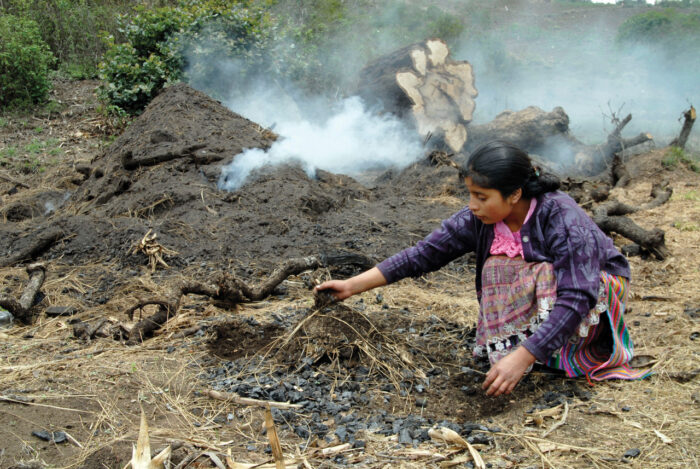
In Central America, 11 of the 25 most contaminated rivers are in Guatemala. The pollution comes from the extractive industries, from the manufacture of soft drinks, from agricultural waste being released into the rivers. We are the source of water for the region, but the water for our population is contaminated.
We have to speak and act. I believe that our defence of our territorial rights as a community is a key element, with international support. We have to work out joint strategies for local action.
Have there been successful anti-mining campaigns in Guatemala?
The non-Indigenous anti-mining resistance movement against the Tambor mine called Resistencia Pacífica La Puya has succeeded. [In 2016, 12 communities in the San José del Golfo and San Pedro Ayampuc area, 28 kilometres north-east of Guatemala City, organised as the Peaceful Resistance La Puya, and halted production at the US-owned goldmine that had been granted a concession in 2011.]
There are examples of resistance other than our own. Self-defence has made us strong, but not all communities are as organised as we are, so we are building solidarity to defend the land, within our communities and outside, strategising with allies outside of the country, as we cannot do it on our own. Not in a country like Guatemala, where we are invisible.
But not everything has been a disaster. There has been solidarity, hope, and collaboration among communities. That is why the strike lasted for 106 days in Guatemala, because there was communication and coordination.
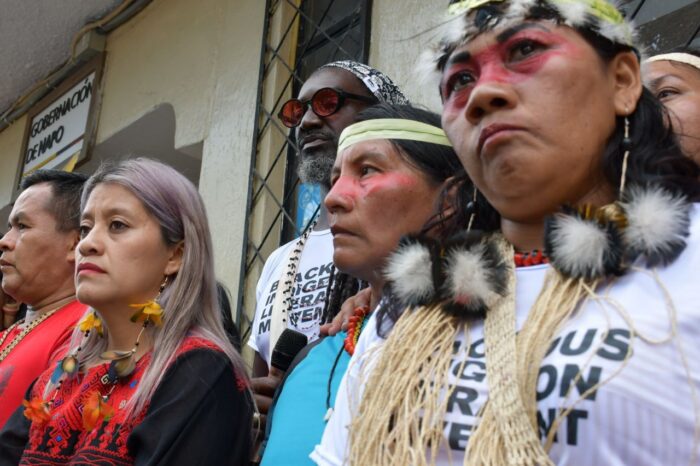
Which were the solidarity groups who supported you in Europe? Have you had any success there?
There was the Collectif Guatemala in France, a group founded by a Guatemalan exile in the 1980s. They understand the Guatemalan context and were able to help us to organise our European tours. There was also PBI [Peace Brigades International] in Berlin and in Hamburg, who paid for our transport.
In December 2023, we pressured the French Ministry of Foreign Affairs to apply sanctions on officials of the dictatorship, and we succeeded. Two weeks after our visit, the French government announced sanctions against Guatemalan individuals, which was important because these functionaries did not want to hand over power to the executive. They did not want a transfer of power, a change of government [Following the election of Bernardo Arévalo to the Presidency in August 2023, the judiciary employed a range of strategies to prevent him from taking office in what was described as an attempt at a “slow coup”. Local demonstrations and international pressure contributed to Arévalo finally being sworn in as President on 15 January 2024.]. What we wanted to do from the outside was to try to influence events in Guatemala. I have continued this kind of international work since then. We tried to go to the European Parliament, to the governments of Germany and France where there were people who supported us, provided us with lodging, or paid for our transport.
In the wider world, we are linked with the Black and Indigenous Liberation Movement (BILM), which brings together grassroots organisations from across the continent, including from Suriname and from Africa. It is very beautiful. Leo Cerda [the Ecuadorian founder of BILM] has been able to secure resources for this and his many other projects, together with Quito Ziegler of the Dandelion project [in New York]. As BILM is not an NGO and does not have consultative status at the United Nations, through Dandelion, we were able to participate in April 2024 at the United Nations Permanent Forum on Indigenous Issues (UNPFII) with our sister organisation, the Coordinadora Andina de Organizaciones Indígenas (CAOI).5)
How do you envisage the future? What are your plans in your community?
We have to stop believing that the answers come from outside: we have them here in front of us, when we are talking about our future. We are already building the future in the form of buen vivir. It is what we are doing every day. We should not be thinking about a great solution to save us. We are already contributing to living alternatives. We have our way of life that we have followed for 5,000 years. There is a phrase, from Kichwa philosophy, one that does not come from my people, which I like very much: ‘traer el pasado adelante es el futuro’ [bringing the past forward is the future] – to continue doing what we have always done, is the future.
We have to stop believing that the answers come from outside: we have them here in front of us…
When we say we are K’iché (and it is important to say this before we talk about conservation) we are saying that we are the forest naming itself. ‘K’iché’ means many trees. I come from a town from the Maya world, one of humanity’s most important civilisations. I do not understand the concept of conservation on the part of the State. We are part of an Indigenous organisation that pre-dates the creation of the nation state system. We administer 320,000 hectares of community forest, one of the most important water sources for Central America. It was cared for by my grandparents, my parents, my brothers and sisters and us.
Our model is one of self-determining communitarianism, of grassroots organisation. It is our role to ‘cultivate’ water, as we say, and to harvest it, so that the rivers flow to Quintana Roo [a Mexican state], for example. When we think of water, we think of trees. The municipality, the local government, began to claim ownership of the forest 20 years ago, although we had a prior-written title of Indigenous ownership. For us, for me, this action by the State, this model, amounts to theft of Indigenous territory. In distributing the land, they are, in effect, expelling us from our territory.
It is important to think about our work in the protection of the communal forest in our territory, as being not for our own benefit, but as protecting biodiversity and the environment for all of us.
In our forest, sadly –we must not romanticise conservation– there are illegal logging networks that operate with the complicity of members of our community who know the territory. It is these illegal networks that we have to confront. They often work hand-in-hand with the State, with the governors, with the mayors, with the multinational logging enterprises.
It is important to think about our work in the protection of the communal forest in our territory, as being not for our own benefit, but as protecting biodiversity and the environment for all of us. The planet is being destroyed, but our approach is not one of tackling an emergency, it is about our way of life, doing what we have always done. This is what is important in the decolonisation project: constructing or changing the narrative. Our protection of the forest is not because of the emergency, not because of the crisis: it is a way of life that we have been practising for 5,000 years.
Our protection of the forest is not because of the emergency, not because of the crisis: it is a way of life that we have been practising for 5,000 years.
The final part of this interview is an adaptation of an extract of Lucia’s speech at the Church Center of the United Nations on 16 April 2024.
Republished courtesy of Latin American Bureau, a link to the original can be found here.
Follow Sounds and Colours: Facebook / Twitter / Instagram / Mixcloud / Soundcloud / Bandcamp
Subscribe to the Sounds and Colours Newsletter for regular updates, news and competitions bringing the best of Latin American culture direct to your Inbox.

